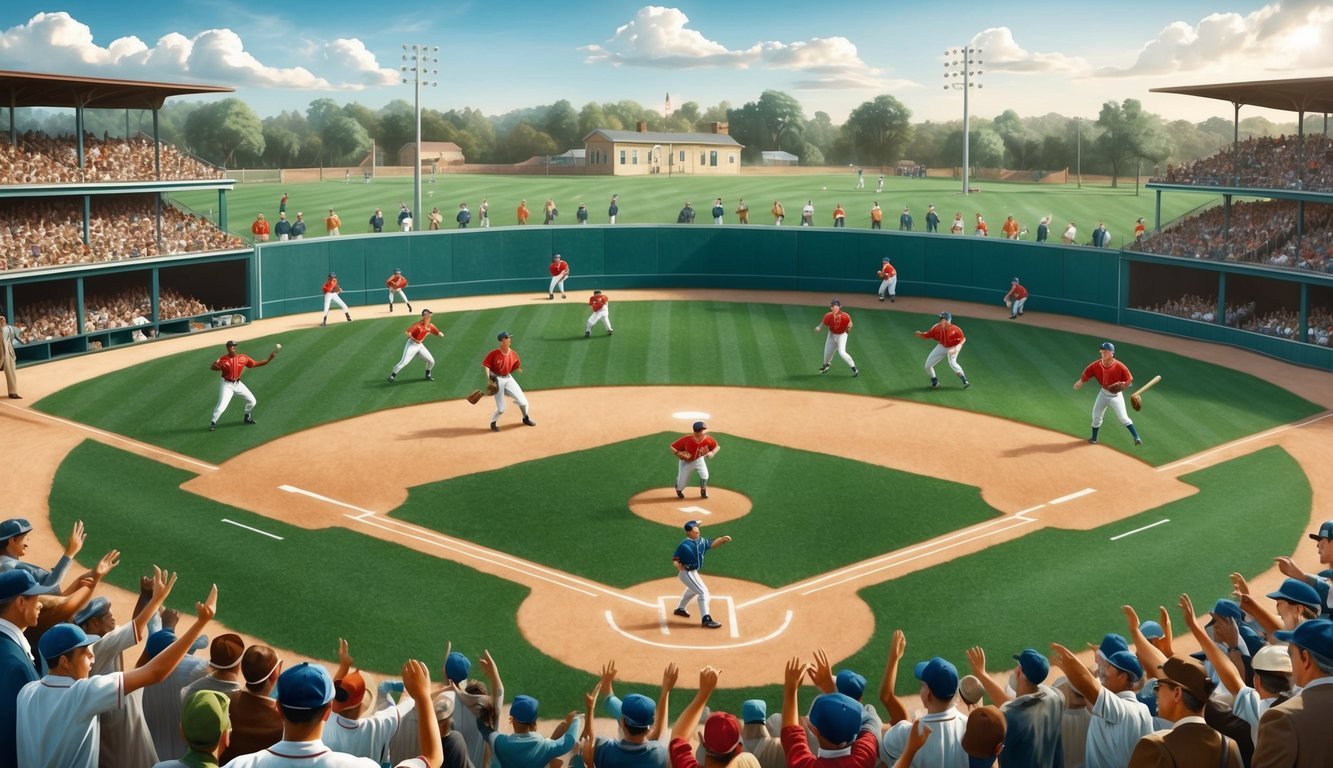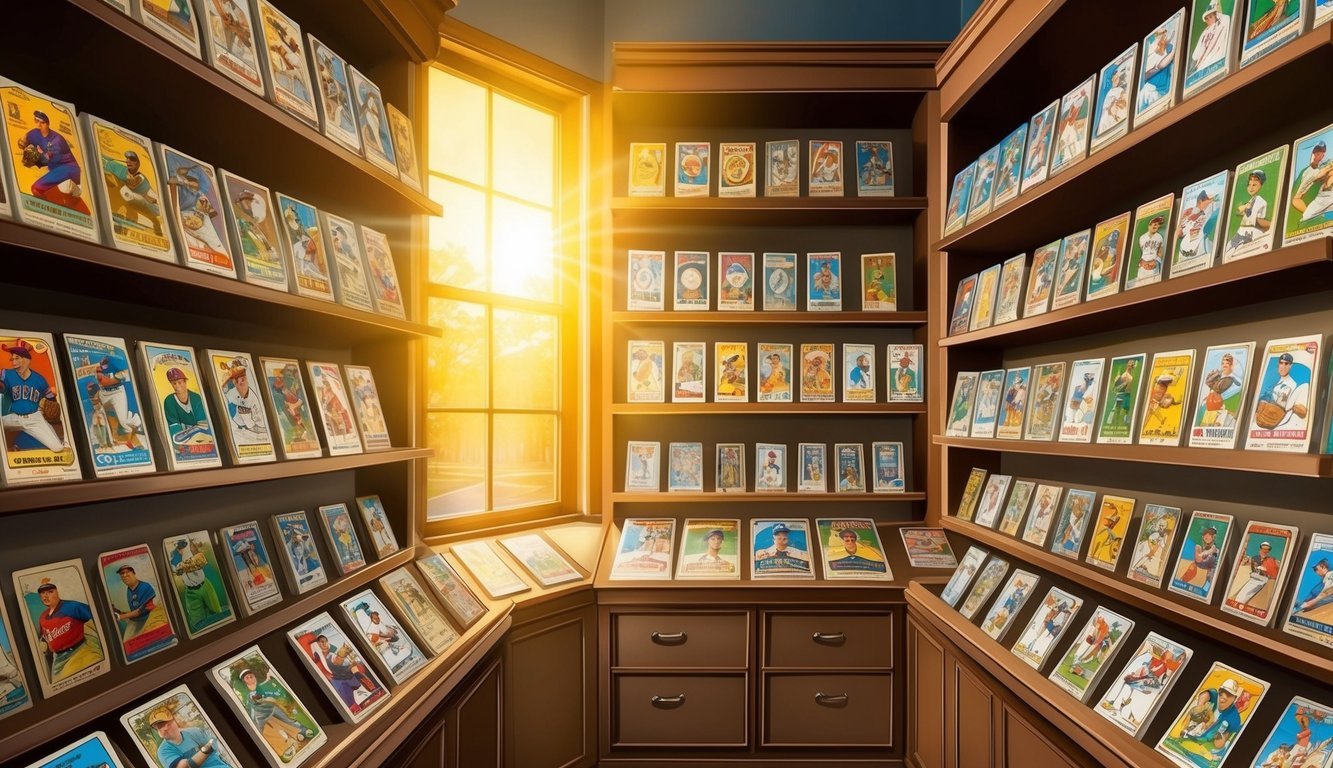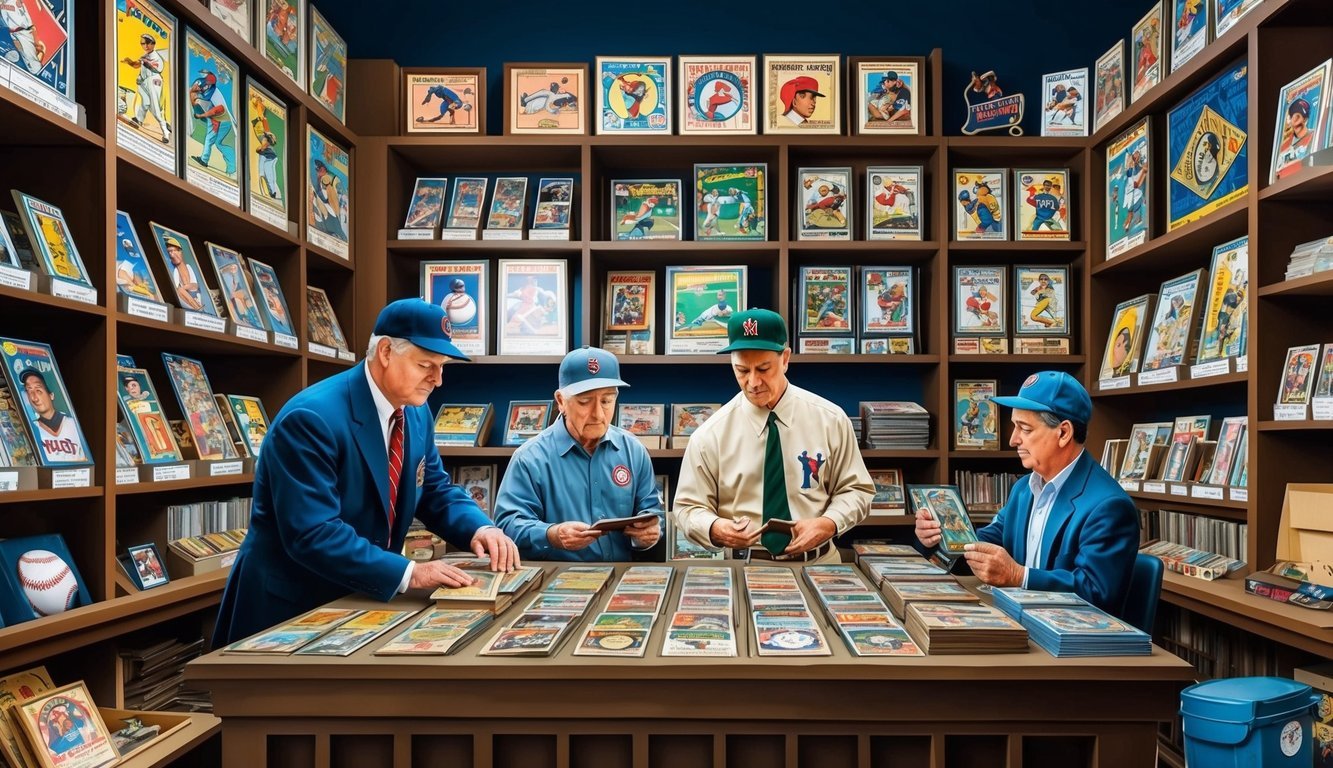Baseball cards have captivated fans and collectors for over a century, evolving from simple advertising tools to valuable pieces of sports history.
Their journey began in the late 1800s when tobacco companies started including small cardboard images of players in cigarette packs.
These early cards featured team photos and individual portraits, showcasing the stars of America’s favorite pastime.
The true baseball card craze took off in the early 1900s as confectionery and gum companies entered the market, targeting young fans with colorful designs and player statistics. The 1933 Goudey Gum Company set, featuring legends like Babe Ruth and Lou Gehrig, marked a turning point in baseball card production.
This set, along with the T206 American Tobacco Company cards and the 1952 Topps series, forms the cornerstone of classic baseball card collecting.
As photography techniques improved, so did the quality and appeal of baseball cards.
They became windows into the sport’s past, preserving iconic moments and players for generations of fans.
Today, rare vintage cards can fetch astronomical prices, while modern cards continue to excite collectors with innovative designs and limited editions.
Origins and Early History

Baseball cards emerged in the late 19th century as promotional items.
They quickly captured the imagination of fans and evolved into cherished collectibles, documenting the sport’s history and its legendary players.
The Inception of Baseball Cards
The first baseball cards appeared in the 1860s.
Peck and Snyder, a sporting goods company in New York, produced cards featuring team photos to advertise their store.
These early cards were given away for free and are now considered the pioneers of baseball card collecting.
In the 1870s, trade cards became popular.
Businesses used these small, colorful cards to promote their products.
Some featured baseball players and scenes, marking the beginning of baseball-themed collectibles.
Tobacco and Gum Cards Era
The 1880s saw tobacco companies embracing baseball cards.
They included small cardboard pictures of players in cigarette packs as stiffeners.
This practice exploded in popularity, with companies like Allen & Ginter and Old Judge producing extensive sets.
The American Tobacco Company created the famous T206 series from 1909 to 1911.
This set included the rare and valuable Honus Wagner card.
In the 1930s, gum companies entered the market.
Goudey Gum Company’s 1933 set, featuring Babe Ruth, became an instant hit with children.
Famous Early Cards
The 1887 Old Judge card of Cap Anson is among the most notable early cards.
Anson, a star player and manager, was one of baseball’s first superstars.
The T206 Honus Wagner card, produced between 1909-1911, is perhaps the most famous.
Its rarity and the player’s legendary status make it highly sought after by collectors.
Early Bowman and Topps cards from the 1950s, featuring young stars like Mickey Mantle and Willie Mays, marked the beginning of the modern baseball card era.
Golden Age and Expansion

The 1930s to 1950s marked a pivotal era for baseball cards, with surging popularity and innovative designs.
Companies began recognizing the marketing potential of these miniature player portraits, leading to widespread distribution and collector enthusiasm.
Rise of Baseball Card Popularity
Baseball cards gained tremendous traction in the early 20th century.
Fans eagerly collected images of their favorite players, with icons like Babe Ruth and Lou Gehrig driving interest.
The cards became a way for enthusiasts to feel connected to the game and its stars.
Companies started including cards as promotional items with various products.
This clever marketing tactic boosted sales while satisfying the growing demand for baseball memorabilia.
Card designs evolved, featuring more detailed player statistics and biographical information.
This added educational value made them even more appealing to young fans learning about the sport.
Cracker Jack and Gum Cards
Cracker Jack made a splash in the baseball card world in 1914 by including cards in their snack boxes.
This move delighted fans and set a new standard for card distribution.
The Goudey Gum Company took things further in the 1930s.
They began packaging cards with bubble gum, creating an irresistible combination for kids and collectors alike.
Other confectionery businesses like American Caramel Company joined in, recognizing the lucrative opportunity.
The marriage of sweet treats and baseball cards proved to be a home run for sales and fan engagement.
Baseball’s Great Depression Effect
Surprisingly, the Great Depression didn’t dampen enthusiasm for baseball cards.
The affordable nature of cards provided a welcome distraction during tough economic times.
Baseball itself remained popular, offering an escape from daily struggles.
This sustained interest in the sport kept demand for cards strong.
Card companies adapted to the economic climate by offering more value.
They introduced larger card sizes and improved print quality to entice buyers, even with limited spending money.
The 1930s saw the emergence of some of the most sought-after vintage cards, paradoxically becoming more valuable due to their scarcity in later years.
Modern Era and Market Dynamics
The modern era of baseball cards brought significant changes to the industry.
Companies introduced new designs, production methods, and marketing strategies to capture collectors’ interest.
Topps and the Monopoly
Topps dominated the baseball card market for decades.
Sy Berger, often called the “father of modern baseball cards,” revolutionized the industry at Topps.
He introduced player statistics, colorful designs, and team logos on cards.
Topps secured exclusive contracts with Major League Baseball, solidifying its monopoly.
This allowed them to produce high-quality cards featuring the biggest stars.
The company’s innovative approach included adding gum to card packs, making them more appealing to young collectors.
Rise of Other Manufacturers
In the 1980s, Topps’ monopoly ended.
Fleer and Donruss entered the market, offering collectors more variety.
Upper Deck joined in 1989, introducing premium cards with holograms and high-quality photographs.
This competition sparked creativity.
Each company tried to outdo the others with unique designs and special inserts.
Bowman, acquired by Topps, focused on rookie cards and prospects.
The increased competition led to overproduction in the late 1980s and early 1990s.
This “junk wax era” flooded the market with cards, temporarily devaluing many collections.
Photographic Evolution and Card Design
Advancements in photography and printing transformed baseball cards.
Kodachrome film allowed for vibrant, true-to-life colors.
High-quality color printing became more affordable, enabling manufacturers to produce visually stunning cards.
Card designs evolved from simple poses to action shots.
Upper Deck pioneered the use of glossy, full-bleed photography.
Manufacturers experimented with different card stocks and finishes.
Digital photography and computer-aided design opened new possibilities.
Cards now feature intricate backgrounds, special effects, and even embedded chips for authenticity.
The evolution from simple strip cards to today’s high-tech offerings reflects the industry’s constant innovation.
Cultural Impact and Collectible Value

Baseball cards have become deeply ingrained in American culture and have achieved significant collectible status.
Their value extends far beyond mere cardboard, representing nostalgia, history, and the legends of the game.
Collectors often seek out rare and vintage cards, driven by the thrill of unearthing a piece of memorabilia that encapsulates a moment in time.
The evolution of collectible baseball card history showcases the changing landscape of the hobby, with new technologies and market trends influencing which cards are deemed most valuable.
This passion for collecting not only preserves the legacy of iconic players but also fosters a sense of community among enthusiasts who share stories and experiences connected to their treasured finds.
Baseball Cards in American Culture
Baseball cards hold a special place in American hearts.
They’ve been cherished by generations, passed down from parents to children.
These small pieces of cardboard capture moments in time, preserving the images of baseball heroes.
Cards often spark conversations and connections between fans.
They’re a gateway to learning about the sport’s history and its greatest players.
Many collectors fondly recall trading cards with friends or flipping through binders of their prized possessions.
The cards have also inspired countless movies, books, and TV shows.
They’ve become symbols of childhood innocence and the enduring appeal of America’s pastime.
Most Valuable and Sought-After Cards
Certain baseball cards have reached legendary status among collectors.
The 1909-1911 T206 Honus Wagner is often called the “Holy Grail” of baseball cards.
Its rarity and the player’s fame have driven its value into the millions.
Other highly prized cards include:
- 1952 Topps Mickey Mantle
- 1916 Sporting News Babe Ruth (rookie card)
- 1909-1911 T206 “Shoeless” Joe Jackson
- 1955 Topps Roberto Clemente (rookie card)
Cards of Hall of Famers like Willie Mays and Jackie Robinson are always in demand.
Condition plays a crucial role in determining value, with perfectly preserved specimens fetching top dollar.
The Role of Auctions and Online Trade
The internet has revolutionized baseball card collecting.
Online auctions have made it easier for buyers and sellers to connect globally.
Sites like eBay have become go-to platforms for trading cards of all values.
High-end auction houses now regularly feature rare baseball cards alongside fine art and antiques.
Record-breaking sales often make headlines, drawing attention to the hobby.
Online resources have also made it simpler for collectors to research card values and authenticity.
Grading services provide professional assessments, giving buyers more confidence in their purchases.
Social media has created new communities of collectors, allowing enthusiasts to share their finds and discuss the hobby.
This digital landscape has breathed new life into baseball card collecting, attracting a new generation of fans.
Evolution of Collecting and Community
Baseball card collecting has transformed over the decades, evolving from a niche hobby into a vibrant community with global reach.
Collectors have adapted to new technologies and market trends, shaping the hobby’s future.
Modern Collecting Practices
Card grading services emerged in the 1990s, revolutionizing the hobby.
Professional Sport Authenticator (PSA) and Beckett Grading Services set industry standards for card condition.
This shift increased card values and market transparency.
Online marketplaces like eBay democratized access to rare cards.
Collectors could now easily buy, sell, and trade with enthusiasts worldwide.
Card shows remained popular, offering face-to-face interactions and opportunities to see valuable cards in person.
Specialized collecting themes gained traction.
Some fans focused on specific teams, players, or eras.
Others pursued complete sets or rare variations.
This diversification broadened the hobby’s appeal.
Digital and Online Communities
Social media platforms connected collectors globally.
Facebook groups and Reddit communities became hubs for sharing knowledge and showcasing collections.
These spaces fostered friendships and collaborative efforts among fans.
Digital card apps like Topps BUNT introduced a new dimension to collecting.
Users could acquire, trade, and display virtual cards.
These apps attracted younger collectors and blended traditional collecting with mobile gaming.
Online forums and blogs became invaluable resources.
Collectors shared tips, discussed market trends, and debated card values.
These platforms helped preserve the hobby’s history and educate newcomers.
The Future of Baseball Card Collecting
Blockchain technology and NFTs are poised to impact card collecting.
Digital assets offer new possibilities for authenticity verification and ownership tracking.
Some see this as a natural evolution, while others prefer physical cards.
Artificial intelligence may soon assist in card grading and authentication.
This could streamline processes and reduce human error.
However, concerns about the loss of human expertise remain.
Environmental considerations are shaping future practices.
Sustainable packaging and digital alternatives may become more prevalent.
Collectors are increasingly conscious of their hobby’s ecological impact.
The hobby’s future likely involves a blend of traditional and innovative approaches.
Physical cards will coexist with digital counterparts.
Community engagement will remain central, adapting to new technologies and collector preferences.
